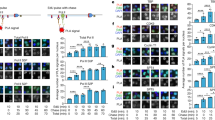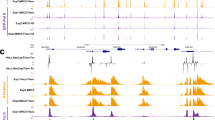Abstract
IT has been established that many eukaryotic mRNAs contain poly(adenylic acid) tracts at their 3′-termini. The polyadenylation of mRNA occurs post-transcriptionally in the nucleus as a rapid, initial addition of 100–200 adenylate residues to the pre-mRNA (ref. 1). Subsequently, a slower chain extension (6–8 bases) of the poly(A) tail seems to occur both in the nucleus and in the cytoplasm2. The initial polyadenylation reaction can be specifically inhibited by the drug cordycepin (3′-deoxyadenosine) in cell culture, presumably by its conversion to the triphosphate analogue which acts as a competitive inhibitor of poly(A) polymerase. Cordycepin, however, has little effect on the slower poly(A) extension reaction3 or on the formation of mRNA precursor molecules4–6; but it can inhibit rRNA synthesis7. Contrary to the in vitro observations, cordycepin 5′-triphosphate (3′dATP) is not a specific inhibitor of poly(A) synthesis in vivo, relative to RNA synthesis8,9, and RNA polymerase I (which synthesises rRNA) is actually less sensitive to inhibition by 3′dATP than RNA polymerase II (ref. 10) (which is presumed to be involved in the synthesis of mRNA). Since nuclear poly(A) polymerase occurs in two functional states as ‘free’ and ‘chromatin-bound’ forms11, we reasoned that if the chromatin-associated poly(A) polymerase were involved in the initial polyadenylation of mRNA, it might be selectively inhibited by 3′dATP. The present studies, designed to test such an idea, demonstrate that, as in vivo, the initial polyadenylation reaction can be selectively inhibited in vitro by low levels of 3′dATP. These data also show that higher levels of 3′dATP can inhibit RNA synthesis, ‘chromatin-bound’ RNA polymerase I activity being significantly more sensitive than the ‘bound’ RNA polymerase II activity.
This is a preview of subscription content, access via your institution
Access options
Subscribe to this journal
Receive 51 print issues and online access
$199.00 per year
only $3.90 per issue
Buy this article
- Purchase on Springer Link
- Instant access to full article PDF
Prices may be subject to local taxes which are calculated during checkout
Similar content being viewed by others
References
Darnell, J. E., Jelinek, W. R. & Molloy, G. R. Science 181, 1215–1221 (1973).
Brawerman, G. Prog. Nucl. Acid. Res. molec. Biol. 17, 117–148 (1976).
Diez, J. & Brawerman, G. Proc. natn. Acad. Sci. U.S.A. 71, 4091–4095 (1974).
Penman, S., Rosbash, M. & Penman, M. Proc. natn. Acad. Sci. U.S.A. 67, 1878–1885 (1970).
Darnell, J. E., Philipson, L., Wall, R. & Adesnik, M. Science 174, 507–510 (1971).
Mendecki, J., Lee, S. & Brawerman, G. Biochemistry 11, 792–798 (1972).
Siev, M., Weinberg, R. & Penman, S. J. Cell Biol. 41, 510–519 (1969).
Horowitz, B., Goldfinger, B. & Marmur, J. Archs Biochem. Biophys. 172, 143–148 (1976).
Maale, G., Stein, G. & Mans, R. Nature 255, 80–82 (1975).
Desrosiers, R., Rottman, F., Boezi, J. & Towle, H. Nucl. Acids Res. 3, 325–341 (1976).
Jacob, S. T., Roe, F. J. & Rose, K. M. Biochem. J. 153, 733–735 (1976).
Yu, F.-L. Biochim. biophys. Acta 395, 329–336 (1975).
Rose, K. M. & Jacob, S. T. Biochemistry 15, 5046–5052 (1976).
Rose, K. M., Lin, Y-Ch. & Jacob, S. T. FEBS Lett. 67, 193–197 (1976).
Rose, K. M., Ruch, P. A., Morris, H. P. & Jacob, S. T. Biochim. biophys. Acta 432, 60–72 (1976).
Jänne, O., Bardin, C. W. & Jacob, S. T. Biochemistry 14, 3589–3597 (1975).
Burton, K. Biochem. J. 62, 315–323 (1956).
Hirsch, M. & Penman, S. J. molec. Biol. 83, 131–142 (1974).
Author information
Authors and Affiliations
Rights and permissions
About this article
Cite this article
ROSE, K., BELL, L. & JACOB, S. Specific inhibition of chromatin-associated poly(A) synthesis in vitro by cordycepin 5′-triphosphate. Nature 267, 178–180 (1977). https://doi.org/10.1038/267178a0
Received:
Accepted:
Issue Date:
DOI: https://doi.org/10.1038/267178a0
This article is cited by
-
A novel nucleoside rescue metabolic pathway may be responsible for therapeutic effect of orally administered cordycepin
Scientific Reports (2019)
-
Development of a fluorescence-based method for the rapid determination of Zika virus polymerase activity and the screening of antiviral drugs
Scientific Reports (2019)
-
The polyadenylation inhibitor cordycepin reduces pain, inflammation and joint pathology in rodent models of osteoarthritis
Scientific Reports (2019)
-
AMPK and PFKFB3 mediate glycolysis and survival in response to mitophagy during mitotic arrest
Nature Cell Biology (2015)
-
Blockade of Smad signaling by 3′-deoxyadenosine: a mechanism for its anti-fibrotic potential
Laboratory Investigation (2013)
Comments
By submitting a comment you agree to abide by our Terms and Community Guidelines. If you find something abusive or that does not comply with our terms or guidelines please flag it as inappropriate.



